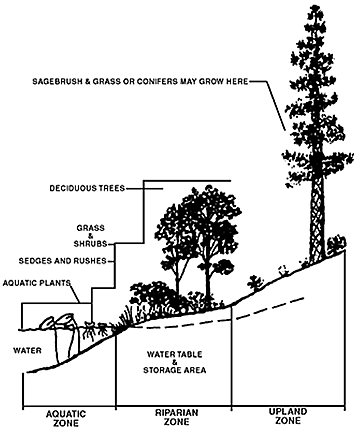Objective: Establish, improve, and maintain riparian zones
(Riparian summary information is from Southeast Aquatic Resources Partnership's Southeast Aquatic Habitat Plan )
"Riparian zones buffer the impacts on adjacent waterbodies from human land use activities while supporting aquatic as well as terrestrial habitats. Wenger (1999) defines riparian zones as land areas located adjacent to waterbodies, often naturally vegetated with grasses, shrubs and trees. Effective riparian zones function as efficient traps, filtering out sediments and nutrients. They provide structure for ephemeral or intermittent channel
flow. Vegetation closest to the waterbody provides cover and habitat for wildlife, helps maintain normal water temperatures, slows over-bank flows, and provides energy in aquatic systems. Vegetative roots, especially from woody plants and trees, decrease erosion of the banks and shorelines (Pollen and Simon 2005). During certain periods or under certain circumstances, riparian zones play significant roles in changing water quality as well as
in the life stages and life-sustaining activities of many aquatic animals. Natural riparian areas also provide important habitat and travel corridors for terrestrial wildlife. Both grassed and forested buffers trap sediment. Forested buffers provide other benefits as well, such as better runoff control while also allowing input of large woody debris and other matter necessary for aquatic organisms (Wenger 1999). Urbanization, industrialization, agriculture and other types of development often degrade or reduce the size or health of riparian areas. Ideally, appropriately sized riparian zones in every watershed in the southeastern region
should be permanently protected. In areas where vegetated riparian areas are already lost or loss is unavoidable, such as urban areas, methods to restore or provide the functions of healthy, natural riparian areas should be explored and utilized. The challenge is to maintain, conserve, permanently protect, construct or restore riparian zones in the southeastern region that can support healthy aquatic habitats and their populations of fish and other aquatic organisms while meeting public needs.
Depending on the region and ecosystem, riparian zones can consist of grasses, sedges, shrubs, woody plants, and trees.
( Riparian diagram from Oregon Watershed Improvement Coalition )
Important functions and benefits of healthy riparian zones:
- Fish and wildlife habitat
- Migratory bird habitat
- Breeding and nesting sites
- Wildlife dispersal corridor
- Area of increased species diversity
- Food source for terrestrial and aquatic organisms
- Bank stabilization and erosion control
- Traps excessive sediments from runoff
- Helps regulate river temperature
- Stores and slowly releases floodwater
- Helps regulate river baseflow
- Recreational and ecotourism opportunities
